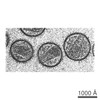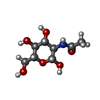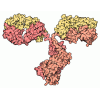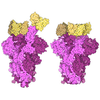[English] 日本語
 Yorodumi
Yorodumi- PDB-9ogu: HIV-1 Env BG505 SOSIP.664-dPG-His in complex with PGT122 and 3BNC... -
+ Open data
Open data
- Basic information
Basic information
| Entry | Database: PDB / ID: 9ogu | |||||||||||||||||||||||||||||||||||||||||||||
|---|---|---|---|---|---|---|---|---|---|---|---|---|---|---|---|---|---|---|---|---|---|---|---|---|---|---|---|---|---|---|---|---|---|---|---|---|---|---|---|---|---|---|---|---|---|---|
| Title | HIV-1 Env BG505 SOSIP.664-dPG-His in complex with PGT122 and 3BNC117 Fabs | |||||||||||||||||||||||||||||||||||||||||||||
 Components Components |
| |||||||||||||||||||||||||||||||||||||||||||||
 Keywords Keywords | VIRAL PROTEIN/Immune System / broadly neutralizing antibody / gp140 / vaccine design / stabilizing mutations / protein design / VIRAL PROTEIN / VIRAL PROTEIN-Immune System complex | |||||||||||||||||||||||||||||||||||||||||||||
| Function / homology |  Function and homology information Function and homology informationmembrane fusion involved in viral entry into host cell / positive regulation of plasma membrane raft polarization / positive regulation of receptor clustering / host cell endosome membrane / clathrin-dependent endocytosis of virus by host cell / viral protein processing / fusion of virus membrane with host plasma membrane / fusion of virus membrane with host endosome membrane / viral envelope / symbiont entry into host cell ...membrane fusion involved in viral entry into host cell / positive regulation of plasma membrane raft polarization / positive regulation of receptor clustering / host cell endosome membrane / clathrin-dependent endocytosis of virus by host cell / viral protein processing / fusion of virus membrane with host plasma membrane / fusion of virus membrane with host endosome membrane / viral envelope / symbiont entry into host cell / virion attachment to host cell / host cell plasma membrane / virion membrane / structural molecule activity / identical protein binding / membrane Similarity search - Function | |||||||||||||||||||||||||||||||||||||||||||||
| Biological species |   Human immunodeficiency virus 1 Human immunodeficiency virus 1 Homo sapiens (human) Homo sapiens (human) | |||||||||||||||||||||||||||||||||||||||||||||
| Method | ELECTRON MICROSCOPY / single particle reconstruction / cryo EM / Resolution: 3.2 Å | |||||||||||||||||||||||||||||||||||||||||||||
 Authors Authors | Andrade, T.G. / Ozorowski, G. / Ward, A.B. | |||||||||||||||||||||||||||||||||||||||||||||
| Funding support |  United States, 1items United States, 1items
| |||||||||||||||||||||||||||||||||||||||||||||
 Citation Citation |  Journal: J Virol / Year: 2025 Journal: J Virol / Year: 2025Title: A modification to heptad repeat 1 of gp41 improves yield and/or quality of soluble pre-fusion HIV-1 envelope glycoprotein trimers. Authors: Devidas N Chaturbhuj / Kwinten Sliepen / Albert Cupo / Benjamin Steinberg / Simon Kazimierczyk / Tarek Munawar / Kyle Kramer / Anila Yasmeen / Thales G Andrade / Wen-Hsin Lee / Lara van der ...Authors: Devidas N Chaturbhuj / Kwinten Sliepen / Albert Cupo / Benjamin Steinberg / Simon Kazimierczyk / Tarek Munawar / Kyle Kramer / Anila Yasmeen / Thales G Andrade / Wen-Hsin Lee / Lara van der Maas / Grace Gibson / Oscar Feliciano / Ivan Del Moral Sanchez / Edith Schermer / Rhianna Bronson / Alison Benner / Madhu Prabhakaran / Rosemarie Mason / P J Klasse / Andrew B Ward / Gabriel Ozorowski / Rogier W Sanders / John P Moore /   Abstract: Native-like HIV-1 envelope glycoprotein (Env) trimers, exemplified by the SOSIP design, are widely used as immunogens, analytical antigens, and for structural studies. These vaccine research and ...Native-like HIV-1 envelope glycoprotein (Env) trimers, exemplified by the SOSIP design, are widely used as immunogens, analytical antigens, and for structural studies. These vaccine research and development programs require trimers that are based on multiple HIV-1 genotypes. While a wide range of protein engineering strategies can produce SOSIP trimers from most Env gene sequences, there are still examples of trimers that are expressed only at impractically low yields or that are unstable. Accordingly, additional protein modifications aimed at overcoming such limitations need to be evaluated. Here, we describe a new heptad repeat 1 modification of gp41, known as dPG, that helps to further stabilize the gp41 component of prototypic and germline-targeting SOSIP trimers in the pre-fusion state and thereby increases post-purification yields substantially. The dPG modification involves a deletion (d) at the highly conserved 566 position that disrupts the heptad repeat and introduces proline (P) and glycine (G) substitutions at positions 567 and 568, respectively. We show that the dPG strategy reinforces previously described stabilization changes in existing SOSIP trimers and can rescue otherwise problematic trimer constructs. The latter includes trimers used to target or analyze human germline antibodies and others derived from the global HIV-1 neutralization panel. In summary, the dPG modification strategy can increase the yield and/or quality of Env trimers that are otherwise difficult to produce. IMPORTANCE: Stabilized, soluble, pre-fusion SOSIP trimers are widely used in HIV-1 Env vaccine research. Protein engineering techniques have identified multiple ways to stabilize SOSIP trimers from a ...IMPORTANCE: Stabilized, soluble, pre-fusion SOSIP trimers are widely used in HIV-1 Env vaccine research. Protein engineering techniques have identified multiple ways to stabilize SOSIP trimers from a range of genotypes. However, some SOSIP trimers remain difficult to express at adequate yields and/or purity, so there is a need for additional modifications. Here, we identified a sequence change, designated dPG, to the gp41 subunit that increases the yield and/or quality of various otherwise problematic SOSIP trimers without compromising their antigenicity or structure. This new modification may have general value for HIV-1 vaccine research and development. | |||||||||||||||||||||||||||||||||||||||||||||
| History |
|
- Structure visualization
Structure visualization
| Structure viewer | Molecule:  Molmil Molmil Jmol/JSmol Jmol/JSmol |
|---|
- Downloads & links
Downloads & links
- Download
Download
| PDBx/mmCIF format |  9ogu.cif.gz 9ogu.cif.gz | 668.6 KB | Display |  PDBx/mmCIF format PDBx/mmCIF format |
|---|---|---|---|---|
| PDB format |  pdb9ogu.ent.gz pdb9ogu.ent.gz | 535.6 KB | Display |  PDB format PDB format |
| PDBx/mmJSON format |  9ogu.json.gz 9ogu.json.gz | Tree view |  PDBx/mmJSON format PDBx/mmJSON format | |
| Others |  Other downloads Other downloads |
-Validation report
| Summary document |  9ogu_validation.pdf.gz 9ogu_validation.pdf.gz | 3.4 MB | Display |  wwPDB validaton report wwPDB validaton report |
|---|---|---|---|---|
| Full document |  9ogu_full_validation.pdf.gz 9ogu_full_validation.pdf.gz | 3.5 MB | Display | |
| Data in XML |  9ogu_validation.xml.gz 9ogu_validation.xml.gz | 106.3 KB | Display | |
| Data in CIF |  9ogu_validation.cif.gz 9ogu_validation.cif.gz | 160.6 KB | Display | |
| Arichive directory |  https://data.pdbj.org/pub/pdb/validation_reports/og/9ogu https://data.pdbj.org/pub/pdb/validation_reports/og/9ogu ftp://data.pdbj.org/pub/pdb/validation_reports/og/9ogu ftp://data.pdbj.org/pub/pdb/validation_reports/og/9ogu | HTTPS FTP |
-Related structure data
| Related structure data |  70476MC  9ogtC M: map data used to model this data C: citing same article ( |
|---|---|
| Similar structure data | Similarity search - Function & homology  F&H Search F&H Search |
- Links
Links
- Assembly
Assembly
| Deposited unit | 
|
|---|---|
| 1 |
|
- Components
Components
-Protein , 2 types, 6 molecules AECFDB
| #1: Protein | Mass: 57945.977 Da / Num. of mol.: 3 / Fragment: UNP residues 30-505 / Mutation: T332N, A501C Source method: isolated from a genetically manipulated source Source: (gene. exp.)   Human immunodeficiency virus 1 / Gene: env / Production host: Human immunodeficiency virus 1 / Gene: env / Production host:  Homo sapiens (human) / References: UniProt: Q2N0S6 Homo sapiens (human) / References: UniProt: Q2N0S6#2: Protein | Mass: 18596.820 Da / Num. of mol.: 3 / Mutation: K567P, L568G Source method: isolated from a genetically manipulated source Source: (gene. exp.)   Human immunodeficiency virus 1 / Gene: env / Production host: Human immunodeficiency virus 1 / Gene: env / Production host:  Homo sapiens (human) / References: UniProt: A0A6H1VYE9 Homo sapiens (human) / References: UniProt: A0A6H1VYE9 |
|---|
-Antibody , 4 types, 12 molecules HMPILQJNRKOS
| #3: Antibody | Mass: 24656.484 Da / Num. of mol.: 3 Source method: isolated from a genetically manipulated source Source: (gene. exp.)  Homo sapiens (human) / Production host: Homo sapiens (human) / Production host:  Homo sapiens (human) Homo sapiens (human)#4: Antibody | Mass: 23022.658 Da / Num. of mol.: 3 Source method: isolated from a genetically manipulated source Source: (gene. exp.)  Homo sapiens (human) / Production host: Homo sapiens (human) / Production host:  Homo sapiens (human) Homo sapiens (human)#5: Antibody | Mass: 25434.691 Da / Num. of mol.: 3 Source method: isolated from a genetically manipulated source Source: (gene. exp.)  Homo sapiens (human) / Production host: Homo sapiens (human) / Production host:  Homo sapiens (human) Homo sapiens (human)#6: Antibody | Mass: 22712.082 Da / Num. of mol.: 3 Source method: isolated from a genetically manipulated source Source: (gene. exp.)  Homo sapiens (human) / Production host: Homo sapiens (human) / Production host:  Homo sapiens (human) Homo sapiens (human) |
|---|
-Sugars , 9 types, 54 molecules 
| #7: Polysaccharide | 2-acetamido-2-deoxy-beta-D-glucopyranose-(1-4)-2-acetamido-2-deoxy-beta-D-glucopyranose Source method: isolated from a genetically manipulated source #8: Polysaccharide | alpha-D-mannopyranose-(1-3)-beta-D-mannopyranose-(1-4)-2-acetamido-2-deoxy-beta-D-glucopyranose-(1- ...alpha-D-mannopyranose-(1-3)-beta-D-mannopyranose-(1-4)-2-acetamido-2-deoxy-beta-D-glucopyranose-(1-4)-2-acetamido-2-deoxy-beta-D-glucopyranose | Source method: isolated from a genetically manipulated source #9: Polysaccharide | alpha-D-mannopyranose-(1-2)-alpha-D-mannopyranose-(1-3)-[alpha-D-mannopyranose-(1-6)]beta-D- ...alpha-D-mannopyranose-(1-2)-alpha-D-mannopyranose-(1-3)-[alpha-D-mannopyranose-(1-6)]beta-D-mannopyranose-(1-4)-2-acetamido-2-deoxy-beta-D-glucopyranose-(1-4)-2-acetamido-2-deoxy-beta-D-glucopyranose | Source method: isolated from a genetically manipulated source #10: Polysaccharide | Source method: isolated from a genetically manipulated source #11: Polysaccharide | alpha-D-mannopyranose-(1-3)-[alpha-D-mannopyranose-(1-6)]beta-D-mannopyranose-(1-4)-2-acetamido-2- ...alpha-D-mannopyranose-(1-3)-[alpha-D-mannopyranose-(1-6)]beta-D-mannopyranose-(1-4)-2-acetamido-2-deoxy-beta-D-glucopyranose-(1-4)-2-acetamido-2-deoxy-beta-D-glucopyranose Source method: isolated from a genetically manipulated source #12: Polysaccharide | beta-D-mannopyranose-(1-4)-2-acetamido-2-deoxy-beta-D-glucopyranose-(1-4)-2-acetamido-2-deoxy-beta- ...beta-D-mannopyranose-(1-4)-2-acetamido-2-deoxy-beta-D-glucopyranose-(1-4)-2-acetamido-2-deoxy-beta-D-glucopyranose Source method: isolated from a genetically manipulated source #13: Polysaccharide | Source method: isolated from a genetically manipulated source #14: Polysaccharide | beta-D-mannopyranose-(1-4)-2-acetamido-2-deoxy-beta-D-glucopyranose | Source method: isolated from a genetically manipulated source #15: Sugar | ChemComp-NAG / |
|---|
-Details
| Has ligand of interest | N |
|---|---|
| Has protein modification | Y |
-Experimental details
-Experiment
| Experiment | Method: ELECTRON MICROSCOPY |
|---|---|
| EM experiment | Aggregation state: PARTICLE / 3D reconstruction method: single particle reconstruction |
- Sample preparation
Sample preparation
| Component | Name: HIV-1 Env BG505 SOSIP.664-dPG-His in complex with PGT122 and 3BNC117 Fabs Type: COMPLEX / Entity ID: #1-#6 / Source: RECOMBINANT |
|---|---|
| Source (natural) | Organism:   Human immunodeficiency virus 1 Human immunodeficiency virus 1 |
| Source (recombinant) | Organism:  Homo sapiens (human) Homo sapiens (human) |
| Buffer solution | pH: 7.4 |
| Specimen | Conc.: 2.6 mg/ml / Embedding applied: NO / Shadowing applied: NO / Staining applied: NO / Vitrification applied: YES |
| Specimen support | Grid material: GOLD / Grid mesh size: 300 divisions/in. / Grid type: UltrAuFoil R1.2/1.3 |
| Vitrification | Instrument: FEI VITROBOT MARK IV / Cryogen name: ETHANE / Humidity: 100 % / Chamber temperature: 277 K |
- Electron microscopy imaging
Electron microscopy imaging
| Microscopy | Model: TFS GLACIOS |
|---|---|
| Electron gun | Electron source:  FIELD EMISSION GUN / Accelerating voltage: 200 kV / Illumination mode: FLOOD BEAM FIELD EMISSION GUN / Accelerating voltage: 200 kV / Illumination mode: FLOOD BEAM |
| Electron lens | Mode: BRIGHT FIELD / Nominal magnification: 190000 X / Nominal defocus max: 1800 nm / Nominal defocus min: 800 nm |
| Image recording | Electron dose: 45 e/Å2 / Film or detector model: FEI FALCON IV (4k x 4k) |
- Processing
Processing
| EM software |
| ||||||||||||||||||||||||
|---|---|---|---|---|---|---|---|---|---|---|---|---|---|---|---|---|---|---|---|---|---|---|---|---|---|
| CTF correction | Type: PHASE FLIPPING AND AMPLITUDE CORRECTION | ||||||||||||||||||||||||
| Symmetry | Point symmetry: C1 (asymmetric) | ||||||||||||||||||||||||
| 3D reconstruction | Resolution: 3.2 Å / Resolution method: FSC 0.143 CUT-OFF / Num. of particles: 210222 / Symmetry type: POINT | ||||||||||||||||||||||||
| Refinement | Highest resolution: 3.2 Å Stereochemistry target values: REAL-SPACE (WEIGHTED MAP SUM AT ATOM CENTERS) | ||||||||||||||||||||||||
| Refine LS restraints |
|
 Movie
Movie Controller
Controller



 PDBj
PDBj





